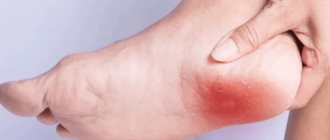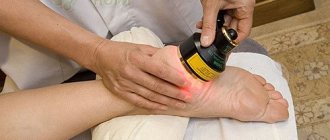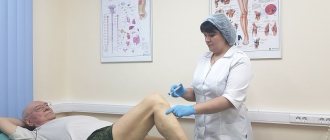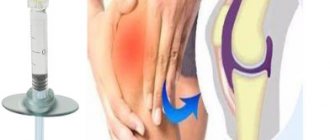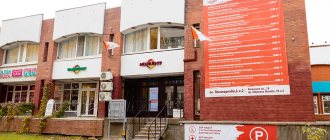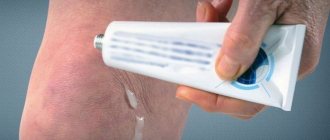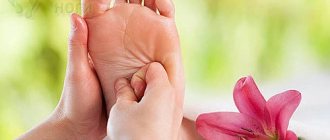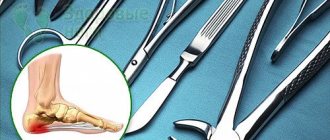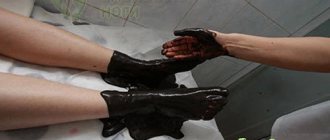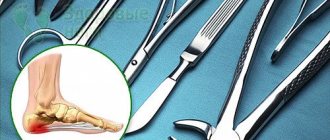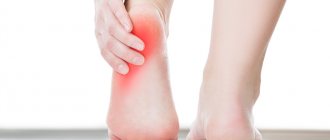A heel spur injection (called a blockade) is an effective way to treat inflammation of the heel fascia by injecting a drug based on artificial hormones directly into the heel spur.
The peculiarity of this method is that the active substance is injected into the affected fascia and begins to act instantly. Steroid injections have many contraindications; only a doctor can prescribe and administer them.
Attention: this article is for informational purposes only. Self-treatment of heel spurs with steroid injections is strictly prohibited!
When is a heel block prescribed for a heel spur?
This method of getting rid of spurs is prescribed if the following conditions are met:
- Other treatments were tried, but they did not give the desired effect.
- The patient experiences severe pain that impairs his quality of life and requires constant pain relief.
- There are no contraindications to the blockade.
If your heel spur hurts unbearably, which doctor should you go to to get a blockade prescribed? The blockade is prescribed and carried out by a surgeon or orthopedist.
Before the procedure, the doctor will prescribe the necessary tests. Women of childbearing age should definitely consult a gynecologist, as well as visit a female doctor after steroid injections.
Attention! There is a misconception that the block is especially effective if performed when the first symptoms of a heel spur appear. In this case, the effect of the injection will be insignificant compared to the possible side effects and complications. In addition, at the initial stage of the disease, introducing the drug into the fascia can only increase inflammation or lead to its rupture.
Indications and contraindications
Blockades are used in several areas of medicine: neurology, orthopedics, traumatology.
Among the indications for the introduction of drugs into tissues:
- Pain in the back, problems with the spine.
- Carpal tunnel syndrome (inflammation of the carpal tissues).
- Osteochondrosis.
- Sciatica, damage to the sciatic nerve.
- Neuritis.
- Neuralgia of any origin.
- Radiculitis.
- Rheumatism.
- Intervertebral hernias in the acute stage.
- Disturbances in the functional activity of tissues after a stroke.
- Postoperative pain.
- Arthrosis.
- Muscle spasms.
- Phantom pain.
- Neuropathies.
- Other chronic pain that cannot be relieved by standard means.
There are not many contraindications:
- Individual intolerance to drugs.
- Acute infectious processes.
- Heart failure.
- Kidney pathology in the stage of decompensation.
- Severe diseases of the central nervous system.
- Pregnancy.
- Unstable course of arterial hypertension with surges in blood pressure.
- Epilepsy.
- Acute mental disorders that exclude adequate perception of reality.
Many contraindications are relative. As soon as the condition has stabilized, the blockade can be resorted to.
Treatment of heel spurs with a heel injection
The point of the procedure is to inject a steroid into the very center of the bone spine. Considering that the thorn has a bone-salt nature, it is quite difficult to inject correctly. It is important to inject directly into the bone growth, and not into the surrounding tissue.
After the administration of a hormonal drug, inflammation decreases significantly. Steroids provoke an acceleration of metabolism and the bone growth resolves.
The main advantage of the blockade is rapid pain relief. Within 2-5 minutes after the injection, the patient feels significant relief.
However, we should not forget that although steroid drugs have a prolonged effect, their therapeutic effect is no higher than that of other conservative treatment methods.
For example, treatment of heel spurs medicinally using non-steroidal drugs with an anti-inflammatory effect gives excellent results, and the use of a foot support for spurs or heel supports speeds up the healing process.
Symptoms
| The main symptom is pain, which is caused by the pressure of the bone growth on the soft tissue and sometimes radiates to the fingers. It appears in the morning and disappears within a few minutes of walking. In the future, if treatment is not started, the pain syndrome does not go away even with rest. The nature of the pain can be different - acute (“as if stepping on a nail”), aching or paroxysmal. |
The next symptom is gait disturbance. The patient tries to spare the affected side and incorrectly redistributes the load on the feet, as a result of which flat feet develop.
Medicine to block heel spurs
Drugs used to block the inflamed fascia have the following effects:
- inhibit the formation of leukocytes in the area of inflammation;
- block the absorbing function of macrophages;
- inhibit the development of inflammatory mediators;
- stabilize cell membranes of healthy cells;
- reduce the permeability of blood capillaries;
- reduces the activity and formation of antibodies.
What injections are given for heel spurs?
The most commonly used drugs are corticosteroids:
Heel spur block with Diprospan
The active substance is betamethasone, which has a long-lasting effect of up to 10 days. Treatment of heel spurs with Diprospan allows you to quickly get rid of pain and relieve inflammation. The drug also has an anti-inflammatory and anti-allergic effect.
The number of injections and dosage is determined by the doctor. As a rule, 1-2 injections are enough to completely remove the spur. Patients should know that Diprospan has a destructive effect on the pituitary-adrenal system and has an impressive list of contraindications.
Hydrocortisone injection
The drug contains artificial hormones similar to those produced by the adrenal glands. To get rid of a spur, a course of 3-5 injections is required.
Injections are made with minimal interruption, while the active substance accumulates in the tissues of the heel and reduces inflammation. It is worth saying that in comparison with Diprospan, this drug is slightly less effective, but its cost is much lower.
Pain relief with Kenalog
A drug based on synthetic corticosteroids. After administration, it instantly relieves pain and promotes the onset of stable remission. Kenalog can be used no more than once every 6-9 months.
Before deciding how to anesthetize a heel spur and prescribe a drug, the doctor should ask the patient about allergies and experience taking hormonal drugs.
When choosing a steroid injection, the specialist takes into account age, gender, weight, history of diseases, as well as test results, ultrasound and x-rays.
How does a shock wave work?
Shock wave is an acoustic wave that delivers energy to the painful area and skeletal muscle tissue in the subacute, subchronic and chronic stages of the disease. Shock waves are characterized by a certain pulse shape and pressure, which usually ranges from 1 to 5 bar, which allows for gentle therapy, while providing a stimulating effect and triggering healing, reparative and restorative processes in biological tissues.
If we consider the treatment of heel spurs specifically, then with the help of a shock wave, calcified fibroblasts are destroyed.
Calcification most often leads to microtears and other tendon injuries. The shock waves “break” the resulting calcifications, which are subsequently removed through the body’s lymphatic system, and thus the condition of the tendons improves.
It is also important to note that UVT not only has a targeted effect on the affected areas, but also has auxiliary healing properties on the body. Thus, in the zone of exposure to waves, metabolic processes improve, significant stimulation of blood flow occurs, especially in the capillaries, which promotes faster resorption of calcium salts, areas of fibrosis and stimulates tissue restoration, which contributes to a speedy recovery of the patient.
Blockade for heel spurs: execution technique
It is impossible to make a blockade on your own for several reasons:
- It is necessary to accurately determine the injection site, and this can only be done by palpation on a relaxed foot or using ultrasound;
- During the injection, the foot should be straight and the heel should remain suspended.
- To reduce the risk of infection, the procedure is carried out in conditions as close to sterile as possible (a clean dressing room or manipulation room in the surgery department).
The effectiveness of the blockade is 90% dependent on the correct administration of the hormonal drug. The depth of the injection and the speed of injection of the medicine are also of great importance.
If inserted incorrectly, the risk of complications increases significantly, so surgeons prefer to carry out this procedure under the control of an ultrasound machine.
It doesn’t matter which drug the doctor chose for the blockade: Hydrocortisone, Kenalog or Diprospan, for heel spurs the injection technique is the same for all drugs:
- Using palpation, the doctor determines the most painful point on the fascia.
- A special syringe with a trocar needle is prepared. Anesthetic 0.5-0.8 ml is drawn up, and then the selected steroid for blockade is drawn up.
- The heel is treated with an antiseptic.
- Under the control of an ultrasound machine, the doctor inserts a trocar needle to the desired depth and slowly injects the medicine.
An anesthetic is used because the procedure is extremely painful. Novocaine, ultracaine and other painkillers can be used as an anesthetic.
After the blockade, the patient should not step on the heel for 30-60 minutes. Subsequently, to reduce pressure on the heel fascia, it is necessary to use insoles for spurs and comfortable shoes.
How the treatment works: video
Already after the first procedure lasting 10-30 minutes, noticeable relief is observed. But for the spur on the heel to disappear, you will need to carry out 4-8 sessions, with 3-7 day breaks between them. We employ highly qualified specialists with many years of experience, which guarantees error-free diagnosis and selection of the optimal treatment method.
During the first sessions and after them, slight pain is possible, which is inevitable when the heel spur is destroyed. However, over time, from session to session, they decrease until complete recovery occurs. With Piezo Shock Wave Therapy, the cure rate for heel spurs is up to 98%.
The number of procedures varies depending on the problem from 4 to 8 sessions, 1-2 times a week according to individual indications.
A course of treatment (at least 5 procedures) allows you to consolidate the positive therapeutic effect for a long time.
Heel spur block: consequences and complications
Complications after the blockade occur in 15-20% of people. In most cases, they are associated with improper administration of steroids and due to the individual characteristics of the body.
By the way, medication and physiotherapeutic procedures for treating heel spurs practically do not cause negative consequences.
The most common complications are:
- suppuration of the injection site and/or adjacent tissues;
- the appearance of signs of osteoparosis;
- tissue death;
- heel fascia rupture.
After the procedure, the person should inspect the heel daily for complications. The first signs that the blockade has caused complications are redness, blackening, pain or numbness of the heel, etc. If you find these or other atypical symptoms, you should immediately contact a surgeon.
Note! Complications after the blockade can occur several weeks after it is carried out. This is due to the prolonged action of steroid drugs.
Causes
A heel spur is a direct consequence of plantar fasciitis, an inflammatory process in the soft tissues at the site of attachment of the plantar aponeurosis (a wide tendon plate that protects the muscles of the foot) to the heel bone. Against the background of inflammatory changes, the aponeurosis becomes coarser and contracts, injuring the periosteum covering the heel tubercle. Irritation of the periosteum leads to stimulation of local growth of bone cells (bone growth in width is carried out due to the cells of the periosteum), and a marginal bone growth (osteophyte) is formed, otherwise called a heel spur.
The most common development factors are degenerative-dystrophic processes in the musculoskeletal system that develop with age. Their appearance in young and middle-aged people is facilitated by such factors as anatomical features, irritation of the periosteum of the heel bone during exercise (running, walking using the wrong technique, on a hard surface, prolonged static standing position, high arches of the feet, excess weight, narrow uncomfortable shoes etc.), microtears of the plantar fascia.
There is a high risk of developing a heel spur with existing foot deformities (plano-valgus deformity, longitudinal and transverse flatfoot), with chronic diseases of the musculoskeletal system - ankylosing spondylitis, gout, arthritis, as well as with specific sports loads.
How to enhance the effect of a heel injection for a heel spur?
To enhance the therapeutic effect of the blockade, doctors recommend following the following tips:
Don't put any weight on your foot
Motor activity must be restored gradually. If you have heel spurs, it is imperative to wear heel pads or Strutz arch supports, which fix the arch of the foot in a natural position and reduce the dynamic load on the heel fascia.
Do gymnastics and foot massage
This is necessary to restore normal blood circulation and metabolism.
Use special creams and ointments.
Use creams that soften the bone spur and have a resolving effect. Products from the Pyatkospor series with medical bile are excellent for the treatment and prevention of inflammation of the fascia. After blocking spurs, use these creams and you will reduce the negative effect of corticoids, soften and moisturize the skin of the heels.
Use of night orthoses
Also, in order to enhance the effect of Diprospan on the heel spur, it is necessary to create a gentle regime for the healing fascia.
The Strasbourg night sock copes well with this task, fixing the foot in a position in which the fascia is subjected to minimal stress and quickly recovers.
Prevention
Prevention of the development of heel spurs is considered compliance with the general requirements:
- maintaining an active lifestyle;
- getting rid of excess weight and other factors that negatively affect the condition of the foot;
- timely treatment of joint diseases;
- correction of foot deformities and movement prevention (physical therapy).
There are no specific preventive measures. External use of ointments, creams and other products with medicinal or biologically active substances does not prevent the development of pathological changes in the musculoskeletal system of the foot.
When is an injection against a heel spur contraindicated?
Even with the most unbearable pain, spur blockade is contraindicated in the presence of the following pathologies:
- tuberculosis, bronchitis and other infections;
- cardiovascular diseases;
- endocrine disorders;
- calcium absorption disorders;
- skin diseases of the feet;
- obesity, etc.
Also contraindicated in women are taking COCs, pregnancy, and gynecological diseases. In each specific case, the decision on how to treat a heel spur is made by the doctor.
Heel injection for heel spurs - reviews and expert opinion
Reviews online about the effectiveness of steroid blockade for heel spurs are divided as follows:
- 55% - injections helped get rid of spurs without side effects or with minimal damage to health;
- 35% - note high effectiveness against the background of significant side effects;
- 10% indicate low effectiveness of the blockade.
The opinion of experts on the use of steroid injections in the treatment of heel spurs is that this method, although it gives an excellent result, is rarely used due to its complexity.
First of all, it is necessary to treat the spur with non-steroidal medications and physiotherapy, and only in the absence of a positive effect can the question of the advisability of the blockade be raised.
Possible complications
Blockade injections for pain have a minimum of complications and side effects. Among the possible options:
- Pain at the injection site, disappearing within a short time.
- Intoxication with anesthetics. A rare complication that occurs in cases where the patient’s body is hypersensitive to the drug and when the dose of the drug is incorrectly calculated. The side effect is short-lived, but the main effect of the drug remains.
- Allergic reactions of varying severity. The doctor must be warned about the existing allergy.
Side effects and complications are the exception to the rule in cases where doctors use safe medications in the correct dosage and also follow the technique of administering medications.
